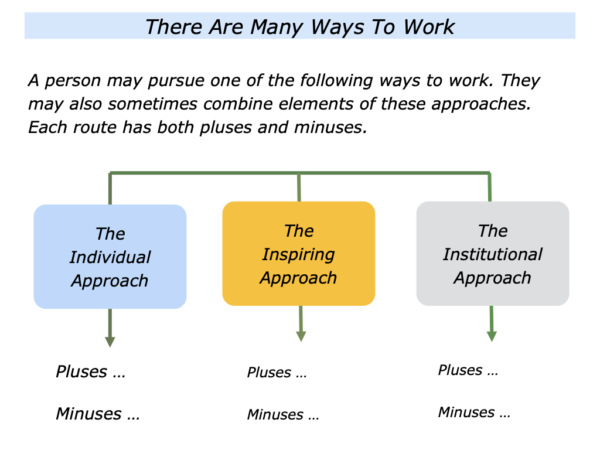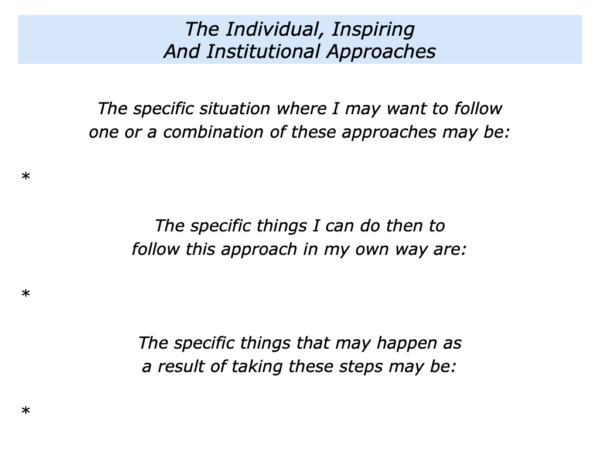
Different individuals follow different paths in the way they work. These include the individual, inspiring and institutional ways. Sometimes they may also combine elements of each of these approaches.
The route a person chooses to follow may be influenced by their personality, their personal strengths and their professional goals. Let’s explore these different ways to work.
The Individual Approach
People who take this route often want to follow their inner drive. They want to feel in control and follow their own way of working. They may work as a freelancer or, at times, as an individual contributor in a team or an organisation
Such an approach has certain pluses. The person can build on their strengths, follow their successful style of working and – if they are savvy – earn a reasonable salary. They may be able to do satisfying work that helps themselves and others to achieve success.
Sometimes there are minuses. The person may find that their style of working may not be accepted or, if they do not manage it properly, may bring them into conflict with others. They may also find it challenging to earn a living doing their preferred kinds of work.
The Inspiring Approach
People who take this route often want to do inspiring work. They may do this as an individual or with other people in a team or an organisation. They may then work through the stages of innovation, implementation and delivering a positive impact.
Such an approach has certain pluses. The person feels alive, alert and creative. They also keep learning. This can help them to keep developing and fulfil their professional goals.
Sometimes there are minuses. The person may need to keep finding or creating inspiring projects. They may also need to manage the workings of some institutions that find it difficult to evolve.
The Institutional Approach
People who take this route often want to work in an institution. They want to contribute to an organisation that has an influence and impact on people’s lives. Some may even want to create an institution.
Such an approach has certain pluses. The person may feel they are in a relatively secure and stable role. They may also like the structured way of working and feel they are doing good work.
Sometimes there are minuses. The person may feel they have little control and are unable to influence the strategy of the institution. They may also find that what appears to be a secure role disappears as a result of changes in the world.
Some people combine elements of each approach. A person may do individual and inspiring work. They then want to pass on this knowledge by institutionalising it in a positive way.
Many people have followed this route. They did good work and passed on a body of knowledge. This led to the setting up of trades, professional bodies or institutions.
Some of these institutions acted as powers for good. They continued to follow their guiding principles – such as the rule of law or maintaining high professional standards.
Some institutions failed to follow their original purpose. They failed to evolve, became obsessed with their own survival or, in some cases, became corrupt.
Let’s return to your own work. Looking ahead, can you think of a situation where you may want to follow one or a combinations of these approaches?
How can you do this in your own way? How can build on the pluses and manage the consequences of any minuses? What may happen as a result of you taking these steps?
If you wish, try tackling the exercise on this theme. This invites you to complete the following sentences.







Leave a Reply